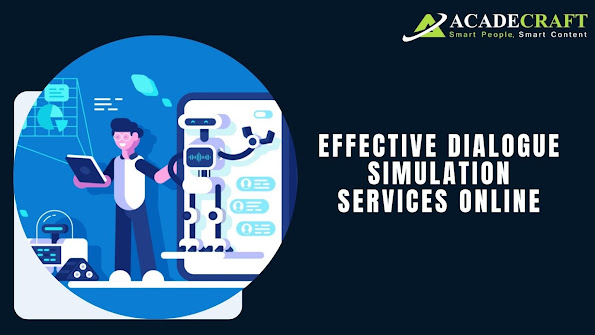Create useful Dialogue Simulations to manage business conversations
Dialogue Simulation is an interactive
exercise that imitates a real person to person conversation. It is and
expertise communication skill that bridges information channel between business
and clients. Dialogue can speak the
interlocutor’s language. In eLearning, business use dialogue simulations
technique to manage conversations. If they find it a technical burden, they ask
dialogue simulation service
provider like Acadecraft, which creates effective end user content. In this
post, we highlight few measures to create dialogue simulations to manage
conversations.
How to create dialogue simulations?
Decide
whether you need a dialogue simulation or not.
Before creating simulations, ask yourself
whether you want to make it or not? What’s my motive behind it? The primary
objective of dialogue simulations is to train workforce good communication
skills in a safe environment to make any mistake in real circumstances.
Dialogue simulations are excessive if your motive is to inform about
regulations, familiarize with a new job, or motivate to work. Add speech
bubbles to your eLearning course that makes it enough for it.
Ponder
over the structure and script
Prepare a blueprint of how to start a
conversation, how to develop and finish it, and where to end. Include
characters and writing lines in proper structure to manage your conversations
effectively. Develop a detailed discussion with appropriate and improper
phrases beforehand. It can be done with any text editor tool, or you can ask dialogue simulation services. It
is essential to inform users about objectives before a dialogue simulation
starts. In this manner, they will pay attention to what is required and get the
expected results. Also, narrate the characters whom learners will communicate.
Define their personality and setting to help learners understand the subject
faster.
Choose
a dialogue simulation type.
After completing the large script, you may
think about how to fit it into the course. Hence, its time to decide the
simulation format. Majorly, there are two types of simulations:
·
Simple simulations
·
Complex simulations
Simple simulations practice or test a
particular skill. For example, an algorithm that overcomes problems. You can
incorporate it to improve memorization of learners after theoretical content
explained.
Complex simulations train several abilities
in one go. A learner can practice different techniques at once. For example,
you can include a course on negotiation with clients where learners require
several skills.
Create
a dialogue
One all the above procedures completed, move to the final one that is creating dialogues. Your eLearning content may require plenty of discussions. Hence you need simulation tools. Organizations may also connect with online Simulation-based dialogue design who designs branches, background and a character for each scene, add voice overs and deduct points for wrong ones


Comments
Post a Comment